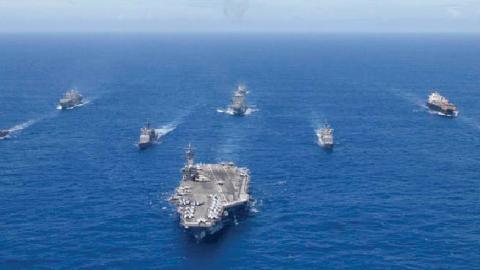The Pentagon’s plan to deter China is rightly coming under fire from Congress and national security experts for double-counting planned procurement and not pursuing the missile defense, interoperability, and training investments requested by two Indo-Pacific Command chiefs. But in addition to falling short of INDOPACOM’s needs, the new defense budget fails to address the more important underlying problem: combatant commanders cannot properly organize and integrate forces in theater to tackle their most challenging operational problems.
Congress established the Pacific Deterrence Initiative in last year’s National Defense Authorization Act to improve the posture and readiness of U.S. forces in the Indo-Pacific region. However, of the $5.1 billion tagged for PDI-related projects in the White House’s 2022 request, most is allocated to ships and aircraft. That’s a stark contrast with INDOPACOM’s PDI assessment earlier this year, which asked for zero additional platforms and instead requested $4.7 billion in 2022 to buy long-range weapons, missile defenses, and critical enablers such as logistics capabilities, training ranges, and support infrastructure. As several lawmakers argued in a recent letter, Congress should revise the PDI plan advanced by the Biden Administration to better address INDOPACOM’s needs.
The INDOPACOM assessment, however, highlights deeper problems with today’s Pentagon force development and management processes. By not asking for platforms but instead focusing on enablers, the assessment puts into stark relief the military services’ emphasis on efficient force development rather than warfighting.
For example, the logistics and readiness improvements INDOPACOM asks for, from a network of U.S. and allied training ranges across the Indo-Pacific to prepositioning sites in Oceania, do not advance service priorities for modernization or growth, and would take money away from their long-term recapitalization efforts. And while the new weapons and missile defenses in INDOPACOM’s proposal are more aligned with traditional service priorities, they would become permanent INDOPACOM forces and essentially constitute a new bill rather than new capabilities services could manage and deploy.
Some analysts argue the combatant commanders should be put on a diet, but the real problem is what the services are feeding them. If former INDOPACOM commander Phil Davidson was correct in his assessment that the PLA could invade Taiwan before the end of this decade, Pentagon officials should focus on the U.S. military’s near- to mid-term capabilities in the Pacific. The U.S. force cannot grow very much in that time, but INDOPACOM’s proposed PDI investments would make the most of the ships, aircraft, and personnel already in the U.S. military or soon to be fielded.
In some ways, INDOPACOM’s proposed PDI portfolio is a Band-Aid. The underlying reason COCOMs need better training facilities, interoperability, or prepositioning is because no organization is equipped to integrate forces in theater. Services organize units into force packages and prepare them for deployment, but once they deploy, the COCOM and its component commanders are responsible for ensuring forces from different services and nations can communicate and work together, have needed logistics support, and are protected from theater-wide threats.
This construct worked well during the three decades following the Cold War when the U.S. military faced poorly equipped regional competitors. Numbered Fleet, Air Force, and Army leaders could, with their unit commanders, cobble together joint and coalition operations where logistics were uncontested and deconfliction was sufficient to achieve operational synergy without fratricide. Against peer competitors like China and Russia, timing, tempo, and complexity will be more challenging. U.S. forces will need to be more highly integrated and their operational infrastructure of fuel, repairs, supplies, and communications able to withstand substantial physical and electronic attack–hence the INDOPACOM PDI proposal.
Another issue raised by PDI is the lack of ownership for mission integration. Even if Congress directs and funds the Pentagon to provide what INDOPACOM requests, most of the capabilities involve multiple services or agencies. Indo-Pacific training ranges support Air Force and Navy needs, for example, while missile defenses could be implemented by the Army, Navy, or Missile Defense Agency.
The Congress should help COCOMs implement regional deterrence initiatives by providing a civilian advocate in the Office of Secretary of Defense to oversee the relevant agency or service programs. These mission managers could focus on specific operational challenges, such defending Guam or improving Indo-Pacific training, and ensure funding is spent as intended and that efforts are integrated to support the COCOM’s needs. The Joint Staff performs this function today but is limited by its inability to direct funding and need to serve multiple COCOM and service constituents.
In addition to ensuring COCOM-specific investments remain on track, mission managers could oversee and integrate efforts such as the new Rapid Defense Experimentation Reserve to satisfy emergent operational needs by service or agency rapid capability offices, software factories, or prototyping and research organizations. Today, these activities are managed by a combination of Joint Staff action officers, service acquisition officials, and headquarters staffs. With such diffuse responsibility, no one is really in charge of these efforts today, which are critical to improving COCOM near to mid-term capabilities and mission integration.
If it is serious about deterring China, Congress should rework the Pentagon’s proposed PDI investment portfolio to address the challenges faced by U.S. forces in the Indo-Pacific. But these are table stakes. To fix the problem of mission integration, Congress should also establish a pilot mission management initiative to ensure COCOMs receive the capabilities they need.
Read in Defense One
















